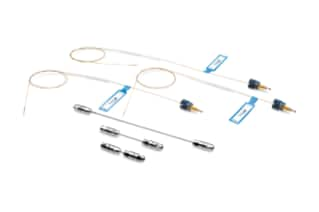Nano and MicroFlow LC-MS Columns
Generate high-quality peptide and protein separations
The ability to reproducibly generate high-quality peptide and protein separations is critically important in proteomics research and biopharmaceutical characterization. Waters Ethylene-Bridged Hybrid (BEH), Charged Surface Hybrid (CSH), and High Strength Silica (HSS) peptide and protein nano columns help address these demanding needs. Combining columns with low retentive trap columns results in highly efficient separations with an increased number of peak identifications.
Waters nano- and microflow LC-MS columns are specifically designed for low-dispersion nano LC systems. The selected stationary phases of these analytical columns fully leverage the separation power of sub-2–µm particle technology at flow rates between 100 nL/min and 50 µL/min, withstanding 15,000 psi, and have an inner diameter between 75 µm – 300 µm. This delivers the efficiency and selectivity required for complex separations like the discovery of low abundance species, peptide mapping, protein identification, and biomarker discovery.
Specifications
Overview
Leverage the efficiency of sub-2–μm particle technology at high flow rates
Stationary phases with a variety of characteristics suitable for low abundance species, peptide mapping, protein identification, and biomarker discovery
Easy interface with LC-MS systems
Available in BEH, CSH, and HSS particle technologies
Recommended Use: For reliable nano, capillary, and microscale UPLC separations of complex peptides and proteins.
Nano and MicroFlow LC-MS Column Featured Technologies
-
Easy-to-use, re-usable, fingertight fittings for nano- and microflow LC-MS
-
15,000 psi (1034 bar) pressure tolerance at 90 °C
-
Compatible with ACQUITY UPLC M-Class, and V-Detail Ports (10–32 threaded ports for 1/16” O.D.)
Nano and MicroFlow LC-MS Column Characteristics
-
Greatly reduce the flow-path induced variability in chromatographic results
-
Deliver the efficiency and selectivity required for complex separations such as discovery of low abundance species, peptide mapping, protein identification, biomarker discovery, and biopharmaceutical characterization
-
Preassembled with ZenFit Connectors
-
Suitable for use with the classic nanoACQUITY UPLC and ACQUITY UPLC M-Class Systems
-
Designed to provide high efficiency sized-based separations for water soluble polymer characterization
-
Uses BEH particle technology
-
Robust separations up to 45 ̊C
-
Suitable for use with the classic nanoACQUITY UPLC and ACQUITY UPLC M-Class Systems
